| Features: Garden projects |  |
The flowery hiccup
Creating a full-blown wildflower meadow in your garden could be a big project; both time consuming and, potentially, expensive (see the feature on the Lodge Lane wildflower meadow). Before going down that road you can experiment with what you've already got by creating a temporary meadow from an area of lawn.
Creating a temporary wildflower meadow This project couldn't be easier to execute, but the results depends critically on what's already there This project couldn't be easier to execute, but the results depends critically on what's already there This project couldn't be easier to execute, but the results depends critically on what's already there. To make one of these temporary meadows, or a 'flowery hiccup' as Chris Baines referred to it in his book How to make a Wildlife Garden, This project couldn't be easier to execute, but the results depends critically on what's already there. To make one of these temporary meadows, or a 'flowery hiccup' as Chris Baines referred to it in his book How to make a Wildlife Garden,  all you need to do is stop mowing for a few weeks starting around middle to the end of May all you need to do is stop mowing for a few weeks starting around middle to the end of May all you need to do is stop mowing for a few weeks starting around middle to the end of May. How easy is that? all you need to do is stop mowing for a few weeks starting around middle to the end of May. How easy is that?
The ideal patch of grass to use is probably your worst area of lawn:  ideal conditions are low fertility with lots of weeds ideal conditions are low fertility with lots of weeds ideal conditions are low fertility with lots of weeds. Many of the 'weeds', when left to grow, will turn out to be just the sort of wildflowers you want to encourage. Low fertility is best because that mitigates against coarse grasses and favours wildflowers, many of which are adapted to conditions of low fertility. Coarse grasses prefer areas of high fertility where they grow quickly and crowd out the wild flowers and finer grasses. If you are lucky, you could find that many beautiful wildflowers have survived under the blades of the lawnmower for years and will relish the opportunity you give them to flower. ideal conditions are low fertility with lots of weeds. Many of the 'weeds', when left to grow, will turn out to be just the sort of wildflowers you want to encourage. Low fertility is best because that mitigates against coarse grasses and favours wildflowers, many of which are adapted to conditions of low fertility. Coarse grasses prefer areas of high fertility where they grow quickly and crowd out the wild flowers and finer grasses. If you are lucky, you could find that many beautiful wildflowers have survived under the blades of the lawnmower for years and will relish the opportunity you give them to flower.
How my meadow developed These pictures illustrate several stages in the short life of my own temporary meadow over May and June 2003. 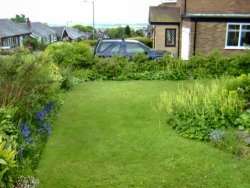 | | Here's the meadow on 19th May, nine days after it was last cut. The grass has begun to grow, but so far, it still looks like an unmown lawn! (View bigger image.) |
| 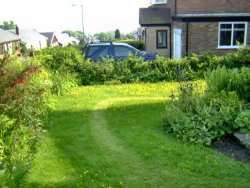 | | Here we are three weeks after the lawn was last cut and there's a fantastic bloom of creeping buttercup (Ranunculus repens), which I expected, and meadow buttercup (Ranunculus acris), which I didn't. (View bigger image.) |
|
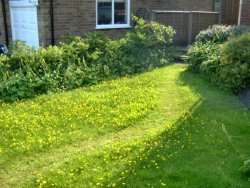 | | This shot shows the path which I continued to mow through the meadow during the whole experiment. Not only did this allow us access to the area without the risk of damaging the plants, it also gave the area a more 'looked after' feel. (View bigger image.) |
| 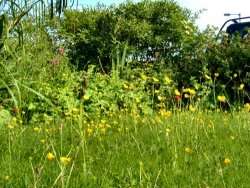 | | A couple of weeks later (now about 5 weeks into the experiment), and I also have fox-and-cubs, or orange hawkweed (Hieracium aurantiacum) flowering in the meadow. (View bigger image.) |
|
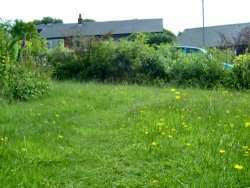 | | A week later and the grass has not really grown any more. The very slow rate of growth of my meadow points to a low soil fertility. (View bigger image.) |
| 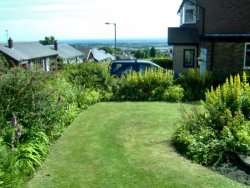 | | It's the end of June and I decide that the meadow has probably shown me what it's got to offer and I, somewhat reluctantly, reintroduce the mower! (View bigger image.) |
|
Lessons to be learned
Whatever form your own 'flowery hiccup' takes (and every one will be different), there will be lessons to be learned from it. I was not particularly fortunate with the range of flowers which grew in my own (see the list below), but it was the grasses which taught me the most about the potential of this lawn as a 'proper' meadow area of the future. These were the flowers that I recorded in my 'meadow' before I put the mower back on it.
- Creeping buttercup Ranunculus repens;
- Meadow buttercup Ranunculus acris;
- Fox-and-cubs Hieracium aurantiacum;
- Dandelion Taraxacum officianalis;
- White clover Trifolium repens.
And the grasses: - Yorkshire fog Holcus lanatus;
- Common bent Agrostis capillaris;
- Rye grass Lolium perenne;
- Sweet vernal-grass Anthoxanthum odoratum;
- Crested dog's-tail Cynosurus cristatus;
- Red fescue Festucs rubra;
- Marsh foxtail Alopecurus geniculatus.
Firstly  I was astonished by the slow rate of growth of the grasses I was astonished by the slow rate of growth of the grasses I was astonished by the slow rate of growth of the grasses. Although left uncut for about seven weeks, there were still patches where the grass was barely 6 inches high. This points to a very low soil fertility: a very good condition for a wildflower meadow. This low fertility is probably due to the fact that although I have mowed the grass regularly for about six years (and always removed the cuttings), I have never fed, dressed or otherwise pampered it in any way! If you've regularly fed your lawn or just have better soil fertility, you may find that your grass grows much more quickly and vigorously. In this case, I was astonished by the slow rate of growth of the grasses. Although left uncut for about seven weeks, there were still patches where the grass was barely 6 inches high. This points to a very low soil fertility: a very good condition for a wildflower meadow. This low fertility is probably due to the fact that although I have mowed the grass regularly for about six years (and always removed the cuttings), I have never fed, dressed or otherwise pampered it in any way! If you've regularly fed your lawn or just have better soil fertility, you may find that your grass grows much more quickly and vigorously. In this case,  your experiment may not last as long as mine: as soon as the vigorous grasses threaten to overwhelm the flowers and finer grasses, return to mowing as normal your experiment may not last as long as mine: as soon as the vigorous grasses threaten to overwhelm the flowers and finer grasses, return to mowing as normal your experiment may not last as long as mine: as soon as the vigorous grasses threaten to overwhelm the flowers and finer grasses, return to mowing as normal. your experiment may not last as long as mine: as soon as the vigorous grasses threaten to overwhelm the flowers and finer grasses, return to mowing as normal.
The second pleasing outcome of my experiment was the range and type of grasses which flowered. The only species which would not be particularly welcome in a wildflower meadow was rye grass which can be very vigorous and competitive. Although rye grass was moderately abundant, by far the most dominant grass in the meadow was the fine-leaved common bent; an excellent meadow grass. The other grasses, which included a small amount of sweet vernal-grass (the species which gives cut hay its sweet smell), were all welcome additions to the meadow flora.
The most valuable lesson for me was that this area is, in many ways, ideal for a small meadow. It has both low fertility, and an excellent grass flora. To turn this area into a 'proper' meadow, I would not have to remove any of the existing soil or vegetation and it would not require reseeding. Simply by selecting an appropriate mowing regime and perhaps introducing some more flowers as plugs, I could produce, over time, a good wildflower meadow. As yet I am undecided as to what course I will take, and if I'm slow to make up my mind, you can be sure that there will be a few more 'flowery hiccups' in summers to come!
| First published July 2003. | |
Copyright Richard Burkmar 2003. Permission is hereby granted for anyone to use this article for non-commercial purposes which are of benefit to the natural environment as long the original author is credited. School pupils, students, teachers and educators are invited to use the article freely. Use for commercial purposes is prohibited unless permission is obtained from the copyright holder. |
Back to home page
Do you live in Merseyside? Interested in its wildlife? | |